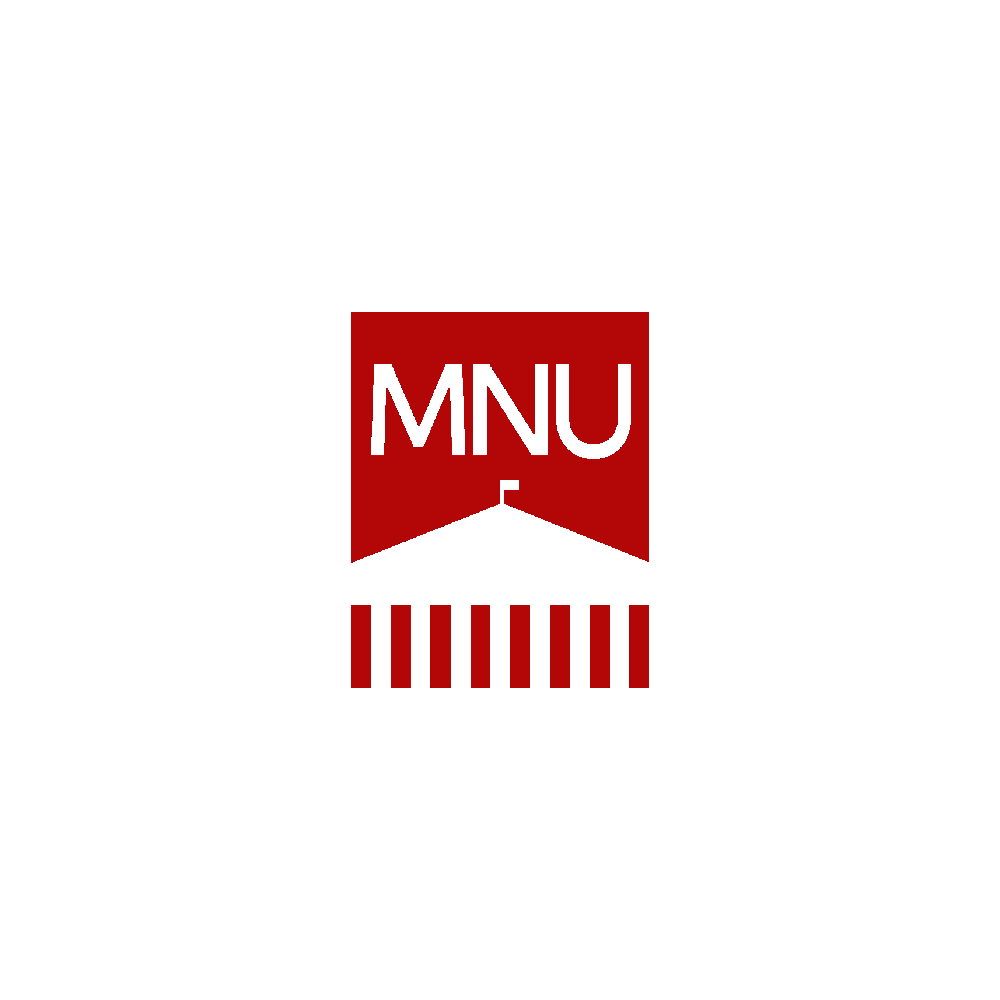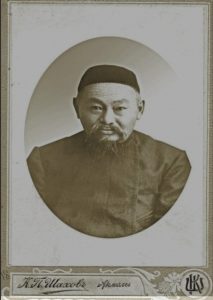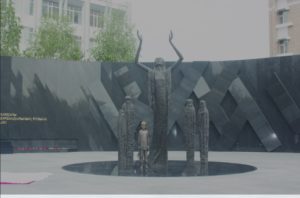

In the pre-revolutionary years, Akmolinsk (now Astana) was a significant trade center due to its strategic location on the caravan route from Petropavlovsk to Tashkent and Kashgar. Major fairs were held in the city during the autumn and spring seasons. In 1890, two stone shopping arcades were built in the central square, known as “Gostiny Dvor“. One of these was the “Green Rows” owned by the merchant Baimukhambet Kosshygulov.

Figure 1. Baimukhambet Kosshygulov
Reference: Baimukhambet Kosshygulov (born in 1843 (1848) – August 27, 1918): From 1911, he was a first-guild Kazakh merchant, entrepreneur, and philanthropist. He began his career with small-scale trade and eventually became one of the wealthiest merchants in the Karaotkel district. Together with his wife, Madina Maksyutova, Baimukhambet had seven children: sons Kurmangali, Mukhammedkali, Uali, Nurmukhambet, Bekmukhambet, Kadyrkey, and daughter Raihan. His sons also engaged in trade, dealing in clothing, fabrics, household chemicals, and groceries.
Baimukhambet was known for his charitable contributions, including donations for the construction of city mosques, though these have not survived to the present day. However, a school for Muslim youth, built with his funds, still stands. His son Kurmangali graduated from the St. Petersburg Institute of Accounting and Cooperative Studies as an economist in trade, becoming one of the first Kazakhs with a higher economic education in the early 1900s.
Anticipating the future of the automotive industry, Kurmangali devised an extensive plan to build an automobile factory in Akmolinsk. In 1913, he secured a contract with Germany, and German engineers from the Opel company began construction of the factory. However, the outbreak of World War I and subsequently the October Revolution thwarted these plans.

Figure 2. The first automobile in the Kazakh steppe was received by Kurmangali Kosshygulov as the grand prize for winning an automobile race in St. Petersburg. This achievement marked a significant milestone in the history of the region, showcasing the pioneering spirit and the forward-thinking vision of the Kosshygulov family.
The Kosshygulov family thrived in both trade and industry. They expanded their trade routes and secured lucrative deals with Russian merchants, while simultaneously opening numerous production enterprises. These included a brick factory, a leather and wool factory, a soap workshop, and facilities for producing household tools, carts, sleds, and more.During that era, Akmolinsk flourished as a trade hub, exporting flour, leather, wool, and livestock to major markets in Russia, Bukhara, Khiva, and Kokand. Under a substantial loan from the Siberian Bank, Baimukhambet Kosshygulov traveled to Paris to acquire blueprints and equipment for a confectionery and gingerbread factory and learn the intricacies of the confectionery business.
Upon returning home, he initiated the construction of the factory in central Akmolinsk.In 1895, the “Kosshygulov and Sons” confectionery and gingerbread factory opened, becoming Kazakhstan’s first food industry enterprise. Kurmangali Kosshygulov, Baimukhambet’s eldest son, was appointed director, with his brothers Nurmukhambet and Uali serving as deputies and co-owners, also managing a network of shops.
The Akmolinsk gingerbreads became a national pride and brand of the domestic food industry. The factory produced honey, sugar, decorative gingerbreads, cookies, rusks, marshmallows, halva, various types of wrapped chocolates, and candies. Kosshygulov’s gingerbreads gained widespread popularity beyond Kazakhstan and Russia thanks to the high quality of white Akmolinsk flour, considered the best in Eurasia. The diverse product range and high quality earned the company victories at all Russian art and industrial exhibitions. In 1915, the company was honored with the supplier title to His Imperial Majesty’s court.
With the advent of Soviet power, the Kosshygulov family’s properties, including warehouses, houses, and shops, were confiscated. The famous confectionery factory was nationalized in 1929. Later, the factory building housed a printing house and editorial offices of regional newspapers. The building stood until 1973 at the intersection of modern Abay and Respublika Avenues. Today, the site features a monumental sculptural composition dedicated to the victims of the 1932-1933 famine, the R&A Center, and the Tourist Hotel Complex (formerly the Abay Hotel and the House of Life).

Currently, the site of the former Kosshygulov confectionery and gingerbread factory is occupied by the sculptural and artistic composition “1932-1933 жылдардағы ашаршылық құрбандарына тағзым“
(Tribute to the Victims of the 1932-1933 Famine). This monument commemorates the victims of the tragic famine that struck Kazakhstan during those years. The composition is a poignant reminder of the historical events and the people’s resilience affected by the famine.